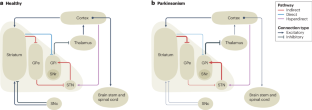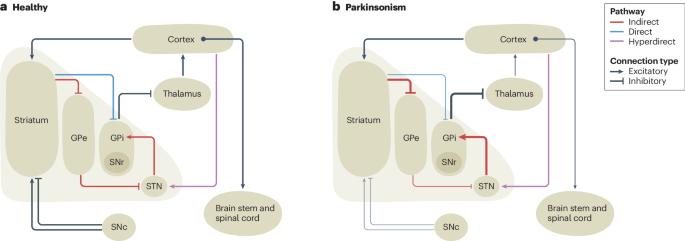为何如此缓慢?帕金森病运动迟缓的模型
IF 26.7
1区 医学
Q1 NEUROSCIENCES
引用次数: 0
摘要
运动迟缓是帕金森病(PD)的一个显著特征,也是导致帕金森病及相关疾病对生活质量产生负面影响的主要原因。帕金森病运动迟缓的主要病理生理学模型已存在了约 30 年,并成为开发多种治疗干预措施的基础,但不断积累的证据使这一模型越来越站不住脚。虽然最近提出了更多的模型,但这些模型似乎也存在缺陷。在本《视角》中,我考虑了之前关于运动迟缓症的主要模型,并认为需要一个与功能更相关的模型,一个考虑到破坏准确信息传递基本过程的变化的模型。为此,我回顾了网络水平功能连接变化、信息传递功能障碍和潜在运动代码传递错误的新证据,并结合这些证据提出了一种新的运动迟缓模型。我希望这一模型能够调和前人研究中的不一致之处,并鼓励进一步开发治疗干预措施。本文章由计算机程序翻译,如有差异,请以英文原文为准。


Why so slow? Models of parkinsonian bradykinesia
Bradykinesia, or slowness of movement, is a defining feature of Parkinson disease (PD) and a major contributor to the negative effects on quality of life associated with this disorder and related conditions. A dominant pathophysiological model of bradykinesia in PD has existed for approximately 30 years and has been the basis for the development of several therapeutic interventions, but accumulating evidence has made this model increasingly untenable. Although more recent models have been proposed, they also appear to be flawed. In this Perspective, I consider the leading prior models of bradykinesia in PD and argue that a more functionally related model is required, one that considers changes that disrupt the fundamental process of accurate information transmission. In doing so, I review emerging evidence of network level functional connectivity changes, information transfer dysfunction and potential motor code transmission error and present a novel model of bradykinesia in PD that incorporates this evidence. I hope that this model may reconcile inconsistencies in its predecessors and encourage further development of therapeutic interventions. There are a number of models that have attempted to explain why people with Parkinson disease move slowly. In this Perspective, Williams identifies the inconsistencies in these models and suggests that these may be addressed by a different model that considers disordered information transmission as fundamental to slow movement development.
求助全文
通过发布文献求助,成功后即可免费获取论文全文。
去求助
来源期刊

Nature Reviews Neuroscience
NEUROSCIENCES-
自引率
0.60%
发文量
104
期刊介绍:
Nature Reviews Neuroscience is a multidisciplinary journal that covers various fields within neuroscience, aiming to offer a comprehensive understanding of the structure and function of the central nervous system. Advances in molecular, developmental, and cognitive neuroscience, facilitated by powerful experimental techniques and theoretical approaches, have made enduring neurobiological questions more accessible. Nature Reviews Neuroscience serves as a reliable and accessible resource, addressing the breadth and depth of modern neuroscience. It acts as an authoritative and engaging reference for scientists interested in all aspects of neuroscience.
 求助内容:
求助内容: 应助结果提醒方式:
应助结果提醒方式:


